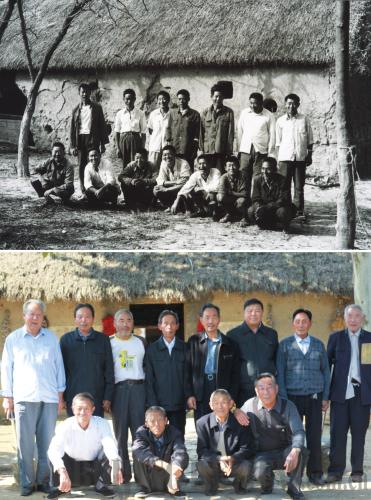|
 |
|
BEFORE AND AFTER: In 1978, 14 of the first 18 farmers from Xiaogang Village of Anhui Province who signed the agreements of land contracts based on households took a group photo in front of a thatched hut of the village. In 2011, 12 of them took another photo in front of the same hut (XINHUA) |
Editor's Note: What can happen in 35 years? A nation turned away from the failed policies of the past and transformed itself into an engine of global economic growth. People who lived on the poverty line are able to live their lives with dignity and respect from the international community. Sweeping changes have taken place in China after the country adopted its reform and opening-up policy. Beijing Review takes a look at how the policy lifted China out of poverty and improved the lives of its people. Included are interviews with two people who benefited from the policy and rose to positions of prominence. Among them are a college professor universally respected and loved by his students; and a woman who became one of the country's youngest mayors.
On December 18, 1978, two days after China and the United States released a joint communiqué announcing the establishment of diplomatic relations, the Third Plenary Session of the 11th Central Committee of the Communist Party of China (CPC) was held in Beijing. Thirty-five years later, China and the United States have become increasingly involved at an economic level. Looking back at this process, one can clearly see that it was the strategic decision to implement the reform and opening up that made it possible for China to integrate itself into the global economy.
China has preformed a miracle within the past 35 years. While the average annual growth of the global economy is only 2.8 percent, China has achieved an average of 9.8 percent, making it a driving force internationally. On top of this, China's rapid development came following the near collapse of the nation in the wake of the "cultural revolution" (1966-76). In 2012 alone, China contributed more than 20 percent of the world's economic growth.
Fast-paced economic growth has also brought incredible social progress: Over the past 35 years, Chinese society has been transformed into a modern and prosperous society, people's livelihoods have improved, democracy and the rule of law have been enhanced, and significant advances have been made regarding science and technology, as well as education and healthcare.
In 2013, many industries and institutions in China commemorated the 35th anniversary of the reform and opening up. By reflecting on the past 35 years, we can not only learn from China's achievements and experiences, but also set clear targets for the future.
Powerful growth
According to figures from the National Bureau of Statistics (NBS), in 1978 China's GDP was 364.5 billion yuan ($59.66 billion), accounting for 1.8 percent of the world economy. In 2012 China's GDP reached 551.89 trillion yuan ($8.49 trillion), becoming the second largest economy in the world and accounting for 11.5 percent of the global economic output.
What is behind China's rapid economic growth? Many Chinese and foreign scholars have conducted research on the topic, but according to Sheng Laiyun, a spokesman for the NBS, the reform and opening up are the fundamental force that drives China's high-speed economic growth.
Taking the contracted responsibility system based on households in rural areas as its starting point, the Third Plenary Session of the 11th CPC Central Committee raised the curtain on China's reform and opening up. The success of the policy is reflected in the fact that China soon became self-sufficient in its food and clothing production and its supplies of produce quickly made the leap from shortage to surplus.
After the rural reforms were successful, China began its industrial reform in 1984, changing the planned economic pattern to one where the government managed enterprises and separated the functions of enterprises from those of the government. Remaining a state-owned economy, China also introduced market mechanisms and no longer restricted the migration of labor. Since then Chinese supplies of industrial products increased, and the rationing of commodities was abolished. During this period, rural enterprises developed rapidly and a large amount of surplus labor in rural areas flocked to the developed coastal regions in southeast China to man its industrial production boom.
| 